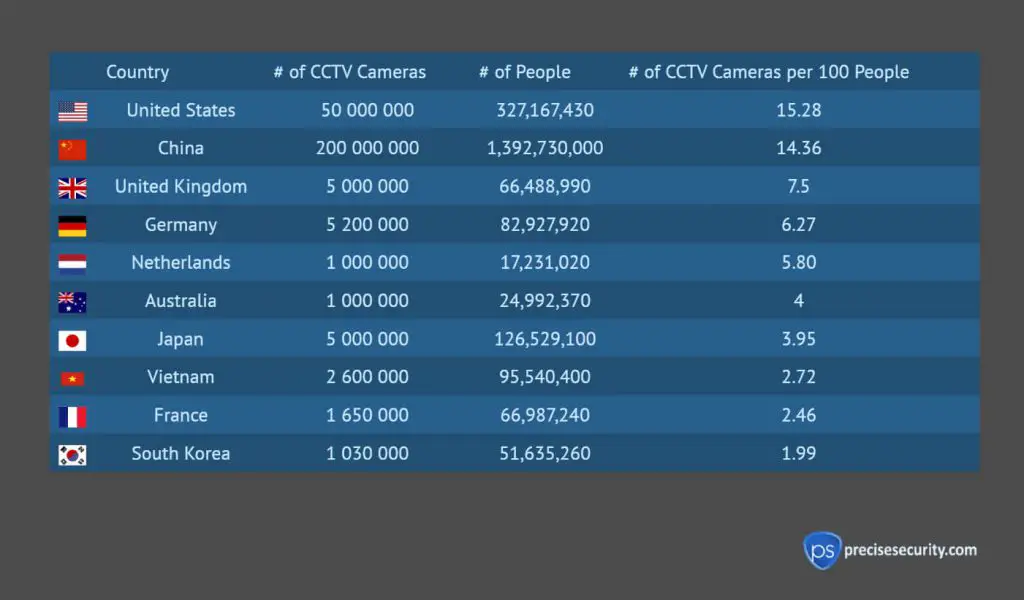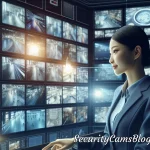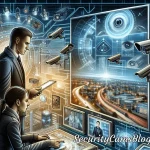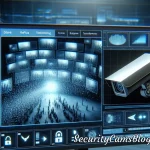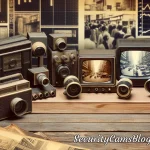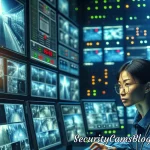The USA has seen a dramatic increase in the use of Closed Circuit Television (CCTV) cameras in recent years, with the technology helping to improve security and safety. In this article, we explore how many CCTV cameras are currently in use in the USA and the ways in which they are helping to protect people and property.
Definition of Security Cameras
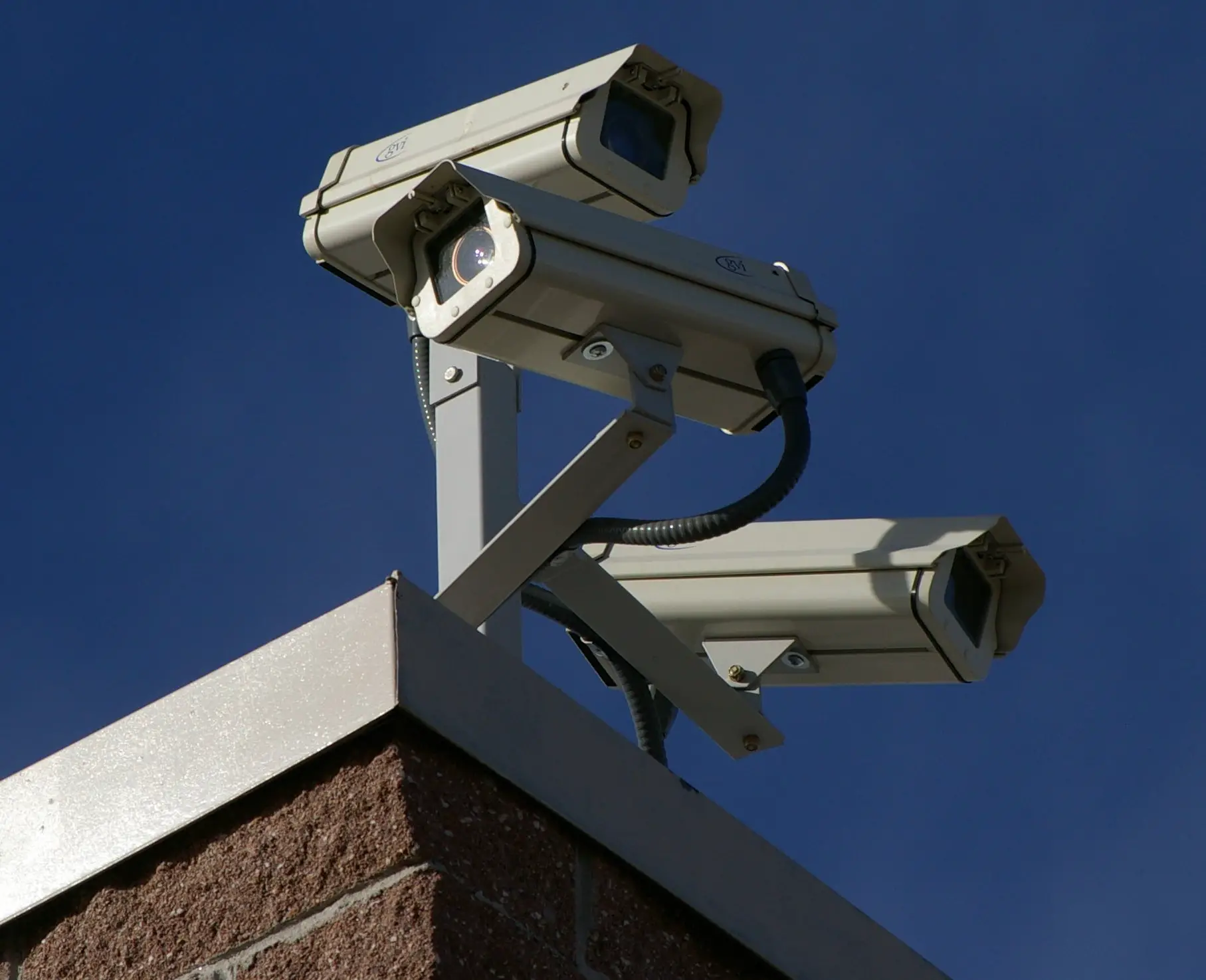
Security cameras, also known as Closed-Circuit Television (CCTV) cameras, are electronic surveillance devices used to monitor and record activity in designated areas. Security cameras are used to enhance public safety and maintain order in a variety of settings, including public and private spaces, retail stores, businesses, schools, and government institutions.
- They can be used to detect suspicious activity, monitor entrances and exits, and capture images of individuals.
- Security cameras provide real-time remote surveillance and recording capabilities, allowing businesses and homeowners to monitor their premises from any location.
- Typically, they are equipped with motion sensors, infrared night vision, and audio recording.
- Modern security cameras are equipped with advanced features such as facial recognition, object detection, two-way audio, and more.
Types of Security Cameras
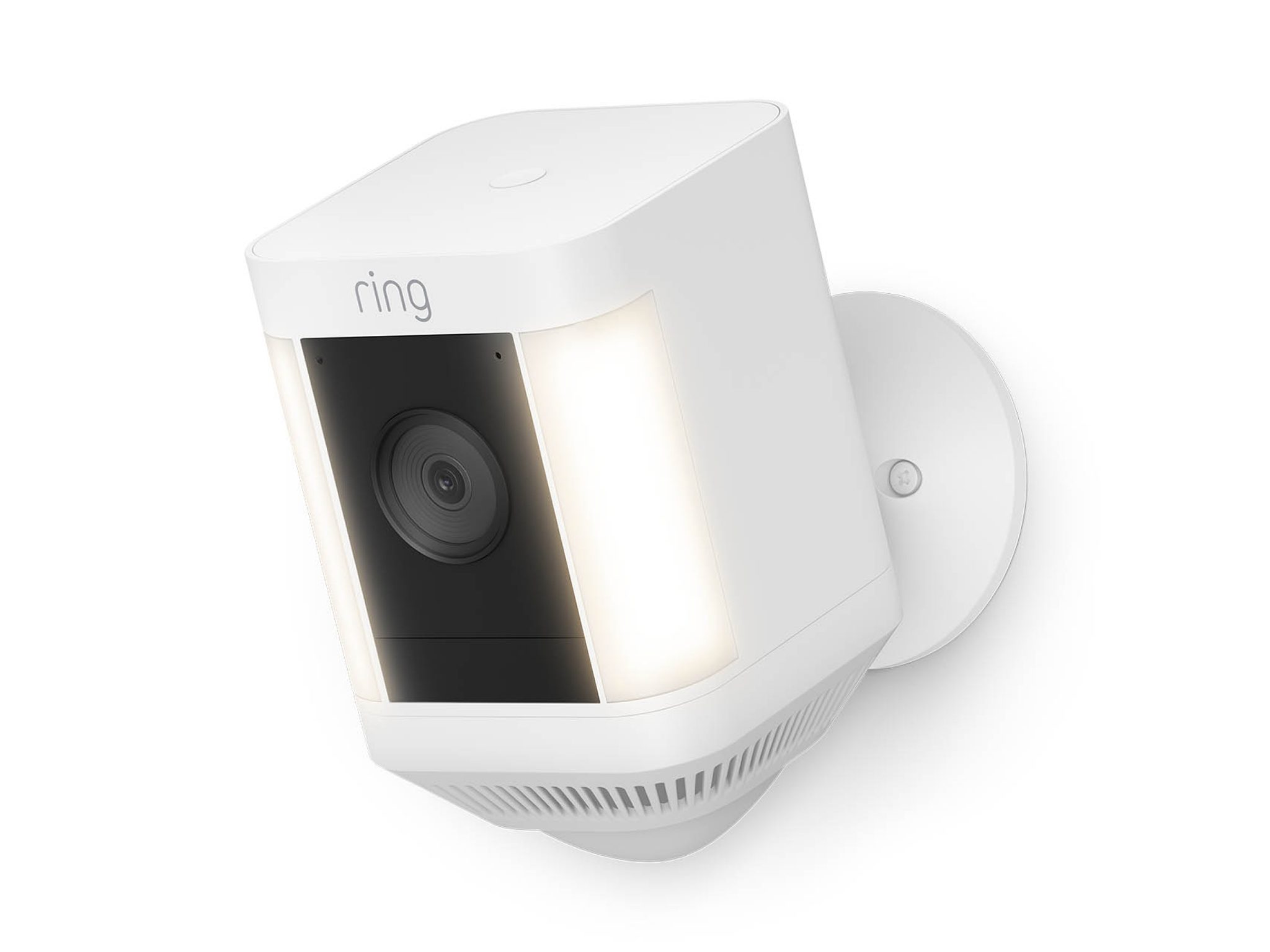
Security cameras are an important tool for businesses, homes, and public places. They are designed to help keep people, property, and assets safe. There are a variety of different types of security cameras available, each designed to meet the specific needs of different environments.
Bullet Cameras: Bullet cameras are one of the most popular types of security cameras. They are small and compact, making them easy to install. They are typically used for indoor surveillance, but can also be used in outdoor settings. Bullet cameras typically have a fixed field of view and are used to monitor a specific area.
Dome Cameras: Dome cameras are typically used for indoor surveillance. They are small and can be easily mounted on ceilings or walls. They are often used in places where a discreet camera is needed, such as retail stores, restaurants, and banks. Dome cameras are designed to provide a wide field of view and are often used in areas where a wide view is needed.
PTZ Cameras: PTZ cameras are used in applications where a wide area needs to be monitored. They are equipped with pan, tilt, and zoom capabilities which allow the camera to move and zoom in and out. They are often used in large warehouses, parking lots, and stadiums.
IP Cameras: IP cameras are the newest type of security camera available. They are connected to the internet and can be accessed remotely. IP cameras are typically used in large and complex environments, such as warehouses and office buildings.
CCTV Cameras: CCTV cameras are the traditional type of security camera. They are used in a variety of applications, from homes to retail stores and public places. CCTV cameras are typically used in places where a wide view is needed and are used to monitor a specific area.
Wireless Cameras: Wireless cameras are becoming increasingly popular. They offer the same features as wired cameras, but don’t require any wiring for installation. Wireless cameras are typically used in areas where running cables is difficult or impossible.
Thermal Cameras: Thermal cameras are used in applications where it’s necessary to identify objects in the dark or low light conditions. They are often used in airports, casinos, and other areas where security is of utmost importance.
These are the most common types of security cameras available today. Depending on the needs of your environment, you can choose the type of camera that best suits your needs.
Advantages of Security Cameras
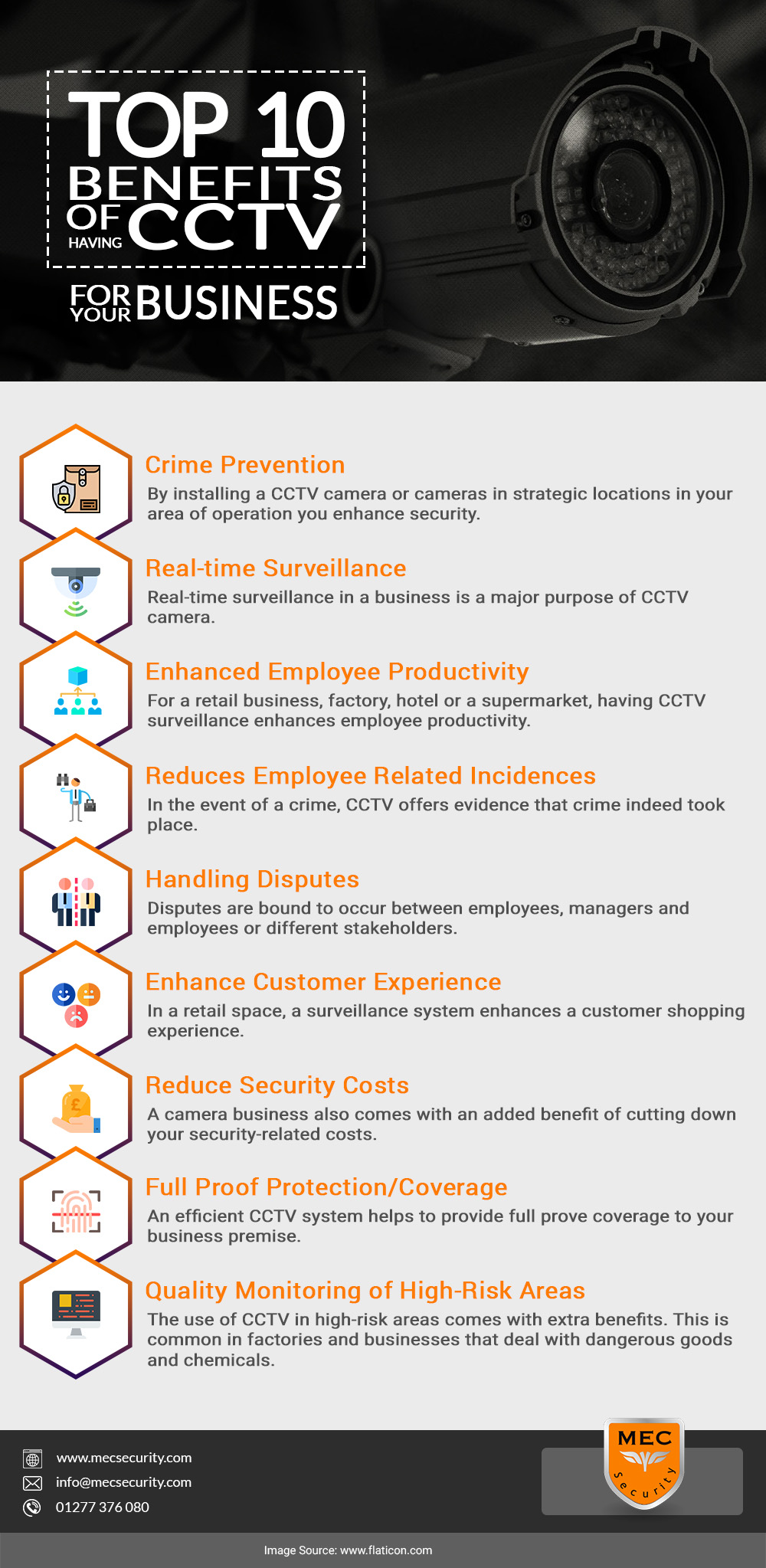
Security cameras are an increasingly popular security measure for businesses and homes alike. They are an effective way to deter crime and monitor activities. There are many advantages to using security cameras, which include:
• Deterring Crime: Security cameras can be a powerful deterrent to criminals. Knowing that they are being monitored can help to discourage thieves and vandals from breaking into a building or property. They can also provide evidence to help identify and prosecute criminals.
• Monitoring Activities: Security cameras allow you to monitor activity on your property. This can help you to identify any suspicious activity and take action to prevent it.
• Improved Safety: Security cameras can help to improve safety on your property. They can provide an extra layer of protection against intruders, as well as monitor activities to ensure that employees and customers are safe.
• Cost Savings: Security cameras can save you money in the long run. By deterring crime, they can help to reduce your insurance premiums. They can also help to reduce the cost of hiring security personnel.
• Increased Productivity: Security cameras can help to increase productivity in your workplace. By monitoring activities, you can identify areas where employees are not performing optimally and take steps to improve their performance.
Overall, security cameras are a great security measure for businesses and homes alike. They provide a powerful deterrent to crime, help to monitor activities, and can provide a cost savings in the long run.
Disadvantages of Security Cameras
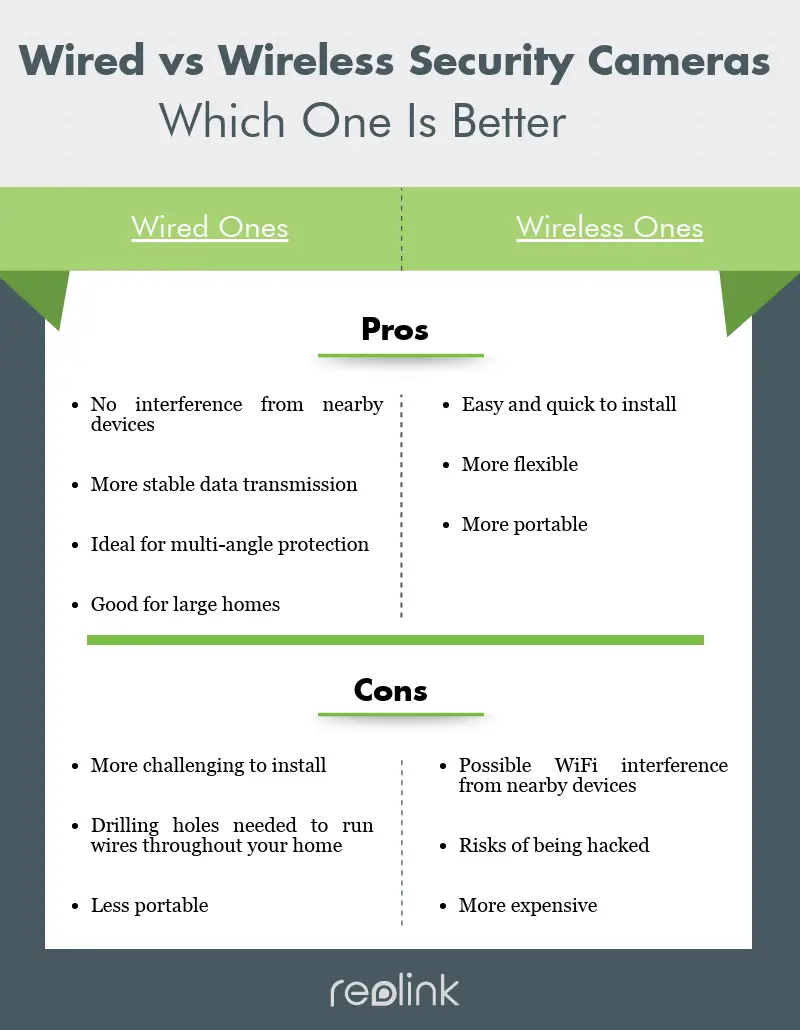
Security cameras can be an effective way to deter crime and provide a sense of security, but they can also have drawbacks. Here are some of the potential drawbacks to consider:
- Expense: Security cameras can be expensive to install and maintain, especially if you have a large system. It is important to factor in the cost of any additional equipment needed, such as monitors and additional wiring.
- Privacy: Security cameras can be a violation of privacy, especially if they are placed in areas where people do not expect to be recorded. This is especially true if people are not notified that they are being recorded.
- False sense of security: Security cameras can give people a false sense of security, as they may feel that they are being watched and safe. In reality, security cameras are not able to prevent crimes from occurring and can only provide evidence after the fact.
- Vulnerability: Security cameras can be vulnerable to tampering or vandalism, and this can lead to the loss of valuable evidence. It is important to choose cameras that are well-protected and resistant to tampering.
Reasons for Installing Security Cameras in the US
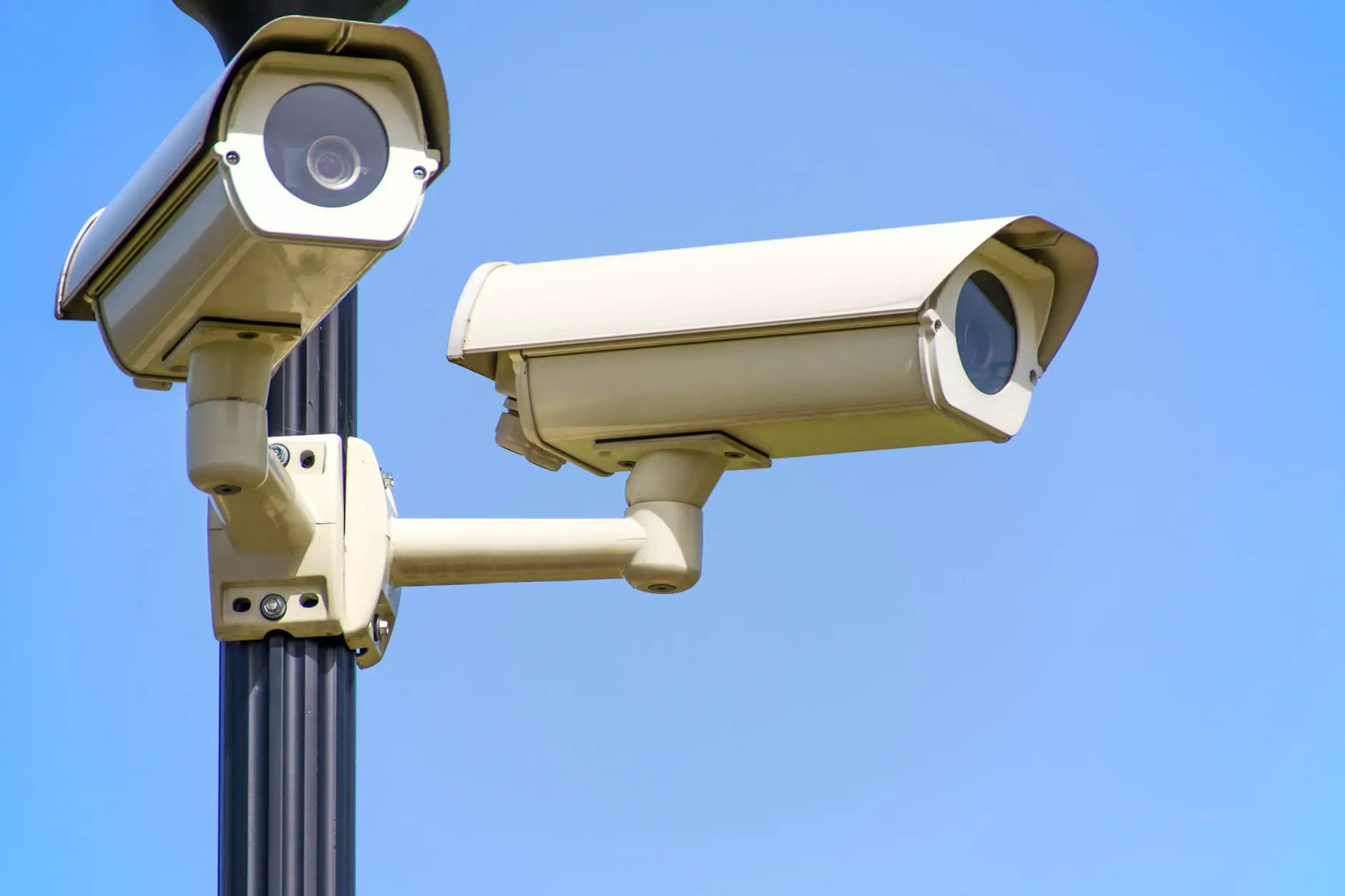
Security cameras in the US are a growing trend. They are becoming increasingly popular as a way to deter crime and keep people safe. With the rise of violent crime, home invasions, and other criminal activities, security cameras have become an essential tool for many Americans. Here are some of the reasons why security cameras are so important in the US.
1. Deterring Crime: Security cameras are an effective deterrent for criminals. They can be used to monitor public areas, detect suspicious activity, and even provide evidence for police investigations. Studies have shown that security cameras can reduce crime in the vicinity by up to 20%.
2. Monitoring Suspicious Activity: Security cameras can be used to monitor suspicious activities such as drug dealing, gang activity, and other illicit activities. This can help police identify and apprehend criminals before they can commit further crimes.
3. Protection for Businesses and Homes: Security cameras can be used to protect businesses and homes from theft and vandalism. They can also be used to monitor employees and customers to ensure that they are following safety protocols.
4. Improving Public Safety: Security cameras can be used to deter criminal activity in public areas, such as parks and shopping areas. This can help reduce the risk of violent crime and other criminal activities in these areas.
5. Proactive Surveillance: Security cameras can be used as a proactive surveillance tool. They can provide police with real-time information about crime, which can help them respond quickly and apprehend criminals.
Security cameras are an essential tool for many American households and businesses. They provide an effective deterrent for criminals, help to monitor suspicious activity, protect businesses and homes from theft and vandalism, and improve public safety. With the rise of crime in the US, security cameras are becoming increasingly popular and are an important part of many security systems.
Estimate of Security Cameras in the US
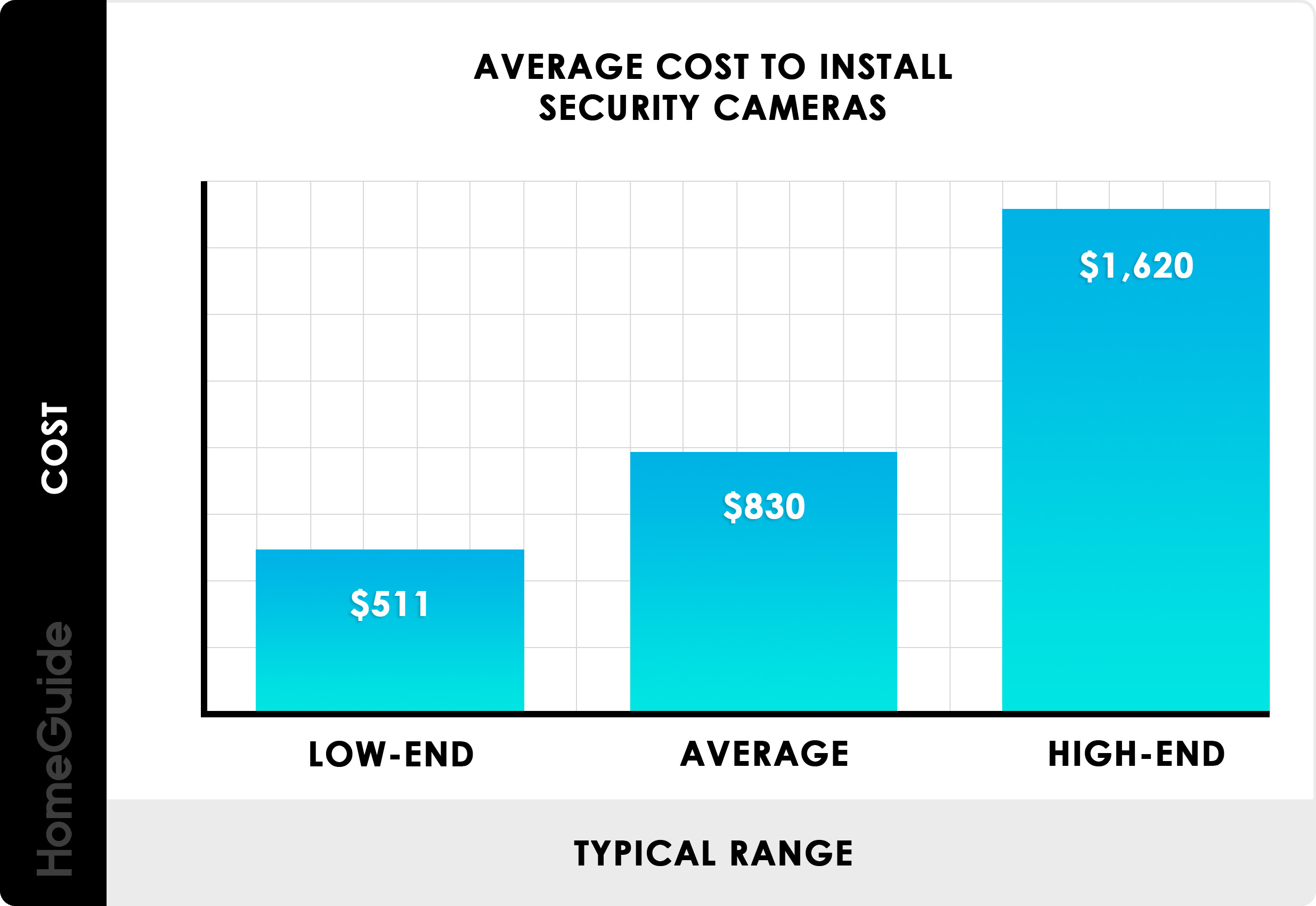
The number of security cameras in the United States is difficult to estimate accurately given the sheer size of the country and the variety of applications for which they can be used. However, it is estimated that there are around 30 million security cameras in the United States, with the majority of them installed in commercial and public spaces.
The vast majority of these cameras are analog CCTV, but more and more digital cameras are being used in recent years. This is due to the advancement in technology and the availability of more affordable cameras. The majority of these cameras are used for security and surveillance purposes, but they are also used for monitoring traffic, recording events, and providing evidence in criminal cases.
| Type of Cameras | Number of Cameras in the US |
|---|---|
| Analog CCTV | 25 million |
| Digital Cameras | 5 million |
In addition to these cameras, there are also an estimated 200 million smartphones in the United States, many of which are equipped with cameras. These cameras are primarily used for personal purposes, but they can also be used for surveillance and security applications.
Given the proliferation of security cameras and smartphone cameras, it is clear that the number of cameras in the United States is quite high and will continue to increase in the future. Security cameras are an important tool in the fight against crime and can help provide valuable information to law enforcement agencies.
State-by-State Estimates of Security Cameras in the US

The number of security cameras in the US is difficult to estimate due to the lack of reliable data. However, there have been several studies attempting to estimate the number of security cameras in each state.
In 2020, a study by the Center for Data Innovation estimated that there were approximately 17.4 million security cameras in the US. Of those, the following table shows the estimated number of security cameras in each state:
| State | Estimated Number of Cameras |
|---|---|
| California | 2,742,500 |
| Texas | 1,890,000 |
| Florida | 1,837,500 |
| New York | 1,662,500 |
| Illinois | 1,087,500 |
| Pennsylvania | 922,500 |
| Ohio | 837,500 |
| Georgia | 722,500 |
| North Carolina | 722,500 |
| Michigan | 662,500 |
The study also estimated that there were approximately 3.3 million security cameras in the five largest cities in the US (New York, Los Angeles, Chicago, Houston, and Philadelphia). It is worth noting that these estimates are based on estimates from 2018 and may not reflect the current situation.
The increasing prevalence of security cameras in the US has raised concerns about privacy and civil liberties. It is important to note that some states, such as California and Illinois, have passed laws regulating the use of security cameras in public spaces. These laws are intended to ensure that individuals’ privacy is protected while still allowing for the use of security cameras.
Overall, due to the lack of reliable data, it is difficult to provide an exact estimate of the number of security cameras in the US. However, the estimates provided in this article can provide a rough estimate of the number of security cameras in each state.
Impact of Security Cameras on Privacy
Security cameras have become an increasingly prominent feature of modern life, with their presence in public spaces, workplaces and homes growing in recent years. Despite their potential to deter crime and protect people, the presence of these cameras can also have an adverse effect on the privacy of individuals.
Security cameras are designed to capture video recordings of public and private spaces, which can be used to detect suspicious activity or monitor people’s movements. This type of surveillance can have a significant impact on people’s privacy, as it can be used to monitor their activities without their knowledge or consent. The use of security cameras can also lead to increased feelings of insecurity among individuals, as they may feel that their privacy is being violated.
In addition, the use of security cameras can also lead to a “chilling effect”—a phenomenon in which people are discouraged from engaging in activities that could be monitored by cameras, such as attending political rallies or speaking out against the government. This type of surveillance can also lead to increased self-censorship, as people may be less likely to express their opinions if they fear that their words may be recorded.
The use of security cameras has also been criticised for its potential to generate false positives—incorrectly identifying innocent people as suspects due to errors in facial recognition or other automated technologies. This can have serious implications for people’s privacy, as innocent people may find themselves subject to scrutiny or investigation.
While security cameras can play an important role in keeping people safe, it is important to ensure that their use is properly regulated and monitored to ensure that people’s privacy is respected. It is also important to be aware of the potential impacts that security cameras can have on people’s privacy, and to take steps to reduce any negative impacts.
Frequently Asked Questions
1. How many surveillance cameras are in the United States in 2021?
The exact number of surveillance cameras in the United States in 2021 is unknown, but estimates suggest that there may be as many as 30 million surveillance cameras in the United States. This figure includes both public and private security cameras, including those in businesses, homes, and government buildings.
The majority of surveillance cameras in the United States are located in cities, with an estimated 19 million cameras in the top five cities alone. New York City has the highest number of surveillance cameras, with an estimated 8 million cameras, followed by Chicago at 5 million, Los Angeles at 4 million, and Dallas and Philadelphia both with 2 million cameras each.
The most common type of surveillance camera in the United States is the closed-circuit television (CCTV) camera. These cameras are used to monitor public places, such as streets, parks, and stores, as well as private spaces, such as offices and homes. CCTV cameras are often connected to digital video recorders (DVRs) that can store footage for later review.
In addition to CCTV cameras, the United States also has millions of “smart” surveillance cameras that are connected to the internet and use artificial intelligence (AI) to detect suspicious activity. These cameras are commonly used in airports, shopping malls, and other public spaces.
The use of surveillance cameras in the United States has become increasingly common in recent years, due to the rise of crime and terrorism. Some states, such as California, have passed laws that limit the use of surveillance cameras in certain locations, while other states have no such laws.
In conclusion, the exact number of surveillance cameras in the United States in 2021 is unknown, but estimates suggest that there may be as many as 30 million cameras in the country. The majority of these cameras are CCTV cameras, with an increasing number of “smart” cameras connected to the internet and using AI to detect suspicious activity.
2. What are the Benefits of Installing CCTV Cameras in the USA?
- Improved security: By installing CCTV cameras in public areas, it is possible to monitor criminal activity, suspicious behavior, and potentially dangerous situations. This can help to reduce the risk of crime and violence in public areas.
- Increased safety: CCTV cameras can be used to monitor activities in hazardous areas, such as construction sites or hazardous materials storage areas. This can help to ensure that dangerous incidents are minimized.
- Improved traffic control: CCTV cameras can be used to monitor traffic flow and road conditions, allowing traffic authorities to identify problems and plan solutions. This can help to improve traffic flow and reduce the risk of accidents.
- Enhanced surveillance: CCTV cameras can be used to monitor the activities of people in public areas, allowing authorities to identify any suspicious behavior and take action accordingly.
- Increased efficiency: CCTV cameras can be used to streamline processes in a variety of industries. For example, in retail settings, CCTV cameras can be used to identify patterns in customer behavior, allowing stores to adjust their strategies accordingly.
3. How do CCTV cameras help to enhance security in the USA?
CCTV cameras are an important tool for improving security in the USA. They can be used to monitor public places and can act as a deterrent to criminal activity. Here are some of the ways CCTV cameras help to enhance security in the USA:
- Monitoring public places – CCTV cameras can be used to monitor public areas, such as streets, parks, and shopping centers, providing an extra layer of security for people who are out and about. The presence of CCTV cameras can act as a deterrent for criminals, as they know they will be caught if they commit a crime in view of the cameras.
- Identifying suspects – CCTV cameras can be used to identify suspects in a crime. The footage can be used to track the movements of suspects, and can help police to apprehend them more quickly.
- Providing evidence – CCTV footage can be used to provide evidence in criminal cases, helping to convict those who have committed a crime. The footage can also be used to exonerate those who have been wrongly accused.
- Reassuring citizens – CCTV cameras can help people to feel more secure and reassure them that the area they are in is monitored by cameras, reducing their fears of crime.
Overall, CCTV cameras play an important role in enhancing security in the USA and protecting citizens from criminal activity.
4. How effective are CCTV cameras in deterring crime in the USA?
The effectiveness of CCTV cameras in the United States in deterring crime is a subject of much debate. While studies have shown that CCTV cameras can reduce crime in certain areas, it is difficult to determine the overall impact of CCTV cameras on crime rates in the United States.
Studies have found that CCTV cameras can be effective in deterring crime in certain situations, such as:
- When cameras are placed in public areas with high levels of crime activity
- When cameras are monitored and responded to quickly
- When cameras are placed in areas with good lighting and visibility
- When cameras are used in conjunction with other security measures, such as patrols and alarms
- When cameras are used in combination with other crime prevention strategies, such as public education and awareness campaigns
However, it is important to note that CCTV cameras cannot completely prevent crime. While CCTV cameras can help reduce the rate of crime in some areas, they cannot completely eliminate it. Additionally, CCTV cameras may not be effective in deterring certain types of crime, such as drug-related crime, which are usually conducted in private areas.
In conclusion, while CCTV cameras can be effective in deterring certain types of crime in certain locations, their overall effectiveness in the United States is unclear.
5. What are the potential drawbacks of installing CCTV cameras in the USA?
- Cost: Installing CCTV cameras in the USA can be costly, as the cost of the camera, installation, and maintenance can all add up. Additionally, if the cameras are part of an extensive network, the cost of networking and data storage can also be a major expense.
- Privacy: CCTV cameras can invade the privacy of individuals by capturing and recording personal activities without consent. This can be especially concerning if the footage is used in an inappropriate way.
- Inaccurate Identifications: CCTV cameras can be used to identify individuals in public spaces, but they are not always accurate and can lead to false identifications. This can have serious implications for individuals who have been falsely identified.
- Data Security: CCTV cameras are connected to a network, which means there is a risk of data being accessed or stolen by hackers. If the data is not properly secured, it can be used for malicious purposes.
- Misuse: CCTV cameras can be misused to invade the privacy of individuals or used to track people’s movements without their knowledge or consent.
Conclusion
The presence of CCTV cameras in the USA has undoubtedly been a major factor in enhancing security in the country. CCTV cameras are in use in major cities and towns, and their use has been increasing steadily over the years. In addition, CCTV cameras are also used by businesses, government buildings, and educational institutions. The use of CCTV cameras has been a major deterrent for crime and has resulted in a considerable reduction in the number of criminal activities. The presence of CCTV cameras has also helped law enforcement agencies to quickly respond to criminal activities and apprehend perpetrators.
In conclusion, the use of CCTV cameras in the USA has been a major factor in enhancing security in the country. The cameras have helped to reduce criminal activities, as well as aid law enforcement agencies in apprehending perpetrators. It is clear that CCTV cameras will continue to play a major role in promoting security in the USA in the future.
References
- Reis, R. (2020, August 19). Number of Surveillance Cameras in the U.S. Surpasses 70 Million. Retrieved from Statista
- Heintz, B. (2020, August 14). How Many Security Cameras Are There in the US? Retrieved from SafeWise
- Hoffman, P. (2020, July 2). Benefits of Surveillance Cameras in the Workplace. Retrieved from Mashable
- Hanke, M. (2020, May 28). How to Choose the Right Security Cameras for Your Business. Retrieved from CSO Online
- Beyer, K., & Fritsch, E. (2019, August 21). CCTV Cameras in the USA: What Are the Laws? Retrieved from CCTV Security Pros

